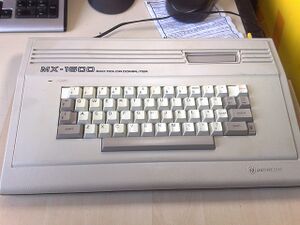Engineering:Dynacom MX1600
 Dynacom MX-1600 | |
| Manufacturer | Dynacom |
|---|---|
| Release date | 1985 |
| Discontinued | 1986 |
| CPU | 6809E @ 0.895 / 1.79 MHz |
| Memory | 64 KB |
| Display | PAL-M color composite or TV RF out |
| Graphics | MC6847 video display generator |
| Sound | 6-bit DAC |
| Backward compatibility | TRS-80 Color Computer |
The MX-1600 was an 8-bit home computer produced in Brazil by the company Dynacom in 1985.[1][2][3][4][5][6][7] It was one of the many clone machines based on the TRS-80 Color Computer introduced during the Brazilian "Market Reserve", like the Codimex CD-6809 or Prológica CP 400 COLOR.[8][9]
History
Launched in August 1985 by Dynacom, a Brazilian video game console manufacturer, the MX-1600 was intended to compete with 8-bit microcomputers such as the Apple II, taking advantage of the success of TRS-80 Color Computer compatibles in the market, based on the excellent sales results of the Prológica CP 400 COLOR.[10]
To differentiate itself from competitors, the MX-1600 was sold with two cassette tapes containing more than one hundred games, applications and utilities, while its biggest opponent, the mentioned CP 400 COLOR, came with a single cassette tape containing only eight programs.[11]
However, sales of the MX-1600 were below expectations and production was shut down in 1986. Although it had plans to launch a MSX standard computer, Dynacom decided to focus on developing IBM PC compatible machines.[12][13]
The Dynacom MX-1600 can be emulated in MAME or XRoar.[14][15][16]
Technical features
The basic features of the Dynacom MX-1600 are similar to the TRS-80 Color Computer, yet there are some differences.
The cartridge slot was in the top right corner of the case, and as a result, cartridges were connected vertically, similar to video game consoles of the time.[5] Only cartridges manufactured or licensed by Dynacom could be used, due to their physical format being different from that of other TRS-80 Color Computer compatibles.
Dynacom also changed the input / output connectors on the MX-1600, preferring not to use standard DIN connectors. This allowed the usage of hardware (ex. joysticks) already manufactured by the company for its video game consoles
- CPU: Motorola 6809E, 890 kHz to 1.8 MHz
- Memory:
- Keyboard:
- Built-in, 59-keys
- Display: Motorola 6847, 9 colors
- Text mode (with 32 x 16 characters)
- Low resolution graphics (with 64 x 32 pixels)
- Medium and high resolution graphics (up to 256 x 192 pixels, 2 colors per pixel)
- Expansion port (cartridges)
- Other ports:
- PAL-M color composite or TV RF out
- RS-232C serial port
- Analogue or digital joysticks
- Cassette recorder (1500 baud, with remote engine control)
See also
References
- ↑ "Dynacom MX-1600" (in Portuguese). https://www.velasco.com.br/index.php?item=dynacommx1600.
- ↑ "Dynacom MX 1600 Computer – 1985" (in Portuguese). 2012-07-08. https://gameplayerspecial.wordpress.com/2012/07/07/dynacom-mx-1600-computer-1985/.
- ↑ "Manual Dynacom MX-1600" (in pt-br). 2015-04-17. https://datassette.org/2015/04/17/manual-dynacom-mx-1600.
- ↑ "Dynacom MX-1600" (in pt-BR). 2021-01-01. https://museucapixaba.com.br/procura-se/dynacom-mx-1600/.
- ↑ 5.0 5.1 Campos, Daniel. "MX-1600: Mais um dos "obscuros" TRS Color nacionais | AMX PROJECT" (in Portuguese). http://amxprojects.com/?p=2146.
- ↑ Pitre, Boisy G.; Loguidice, Bill (2013-12-10) (in en). CoCo: The Colorful History of Tandy's Underdog Computer. CRC Press. pp. 83. ISBN 978-1-4665-9247-6. https://books.google.com/books?id=9oJcAgAAQBAJ&dq=Dynacom+MX1600&pg=PA83.
- ↑ "epocalc - Computer models database". http://www.epocalc.net/php/liste_models.php?texte=MX-1600&look=All+fields&yearmax=2025&nocomp=pc.
- ↑ Benassi, Elaine; H. Bersch, Fernando (in Portuguese). A História da informática no Brasil. http://www.boaaula.com.br/iolanda/hic/hicbra0m.doc.
- ↑ "CP-400" (in Portuguese). http://museuvirtual.unipar.br/raridades/cp-400.
- ↑ Administração (2020-07-31). "Dynacom MX1600" (in pt-BR). https://computadoresbrasileiros.wordpress.com/2020/07/31/dynacom-mx-1600/.
- ↑ "MX-1600 - Relação de Software" (in pt-br). 2019-11-23. https://datassette.org/manuais/br-brasil-aplicativos-trs-color-tandy-manuais/mx-1600-relacao-de-software.
- ↑ "Canal-3 A Entrevista com Gabriel Almog" (in Portuguese). 2002. http://muriloq.com/canal3/0203/31042.html.
- ↑ "Linha do Tempo dos Computadores Pessoais e Portáteis (Criadores, Fabricantes, Hardwares, Softwares, Internet, Periféricos, Calculadoras): "Tamanho não é Documento"… (e "Quem" ou o "Que" os conduziram ao estrondoso sucesso atual!)" (in pt-BR). 2011-02-05. https://retroplayerbrazil.wordpress.com/2011/02/05/linha-do-tempo-dos-computadores-pessoais-tamanho-nao-e-documento/.
- ↑ Motoschifo. "MX-1600 - MAME machine" (in it). http://adb.arcadeitalia.net/?mame=mx1600.
- ↑ Old, Vintage is The New. "XRoar – The all-in-one emulator for the TRS-80 Color Computer and Dragon" (in en-US). https://www.vintageisthenewold.com/xroar-the-all-in-one-emulator-for-the-trs-80-color-computer-and-dragon.
- ↑ "XRoar, a Dragon and Tandy 8-bit computer emulator". https://www.6809.org.uk/xroar/index.shtml.
 |

